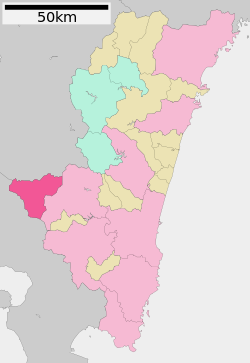Ebino, Miyazaki
|
Ebino えびの市 |
||
|---|---|---|
| City | ||
|
||
 Location of Ebino in Miyazaki Prefecture |
||
| Location in Japan | ||
| Coordinates: 32°2′N 130°49′E / 32.033°N 130.817°ECoordinates: 32°2′N 130°49′E / 32.033°N 130.817°E | ||
| Country | Japan | |
| Region | Kyushu | |
| Prefecture | Miyazaki Prefecture | |
| Government | ||
| • Mayor | Michihiro Miyazaki | |
| Area | ||
| • Total | 283.00 km2 (109.27 sq mi) | |
| Population (October 1, 2005) | ||
| • Total | 23,079 | |
| • Density | 81.55/km2 (211.2/sq mi) | |
| Symbols | ||
| • Tree | Kirishima Red Pine | |
| • Flower | Calanthe discolor (海老根 Ebine) | |
| Time zone | Japan Standard Time (UTC+9) | |
| City hall address | 1292 Ōaza Kurishita, Ebino-shi, Miyazaki-ken 889-4292 |
|
| Website | www |
|
Ebino (えびの市 Ebino-shi?) is a city located in Miyazaki Prefecture, Japan.
Ebino shares borders with Kagoshima Prefecture, Kumamoto Prefecture and Kobayashi, Miyazaki Prefecture.
As of October 1, 2005, the city has an estimated population of 23,079 and a population density of 81.55 persons per km². The total area is 283.00 km².
The town of Ebino was created through the administrative merging of the towns of Masaki, Kakutō and Īno in 1966. Ebino was designated a city on December 1, 1970.
Ebino produces a wide range of food products, from shōchū to sweets, tea, honey, mushrooms, chicken and pork. Locally produced crafts include Ebino-yaki pottery and bamboo craftwork, among others.
Ebino can be reached via the Kyūshū Expressway as well as national highway routes 221, 268, and 447.
Ebino is also accessible via express and regular buses.
The following train lines and stations operate in Ebino.
...
Wikipedia


